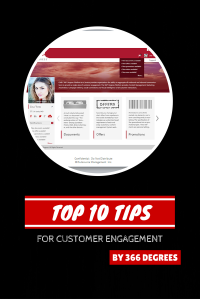The concept and discipline of Customer Engagement is one that many organizations are using to communicate with customers in new and more profitable ways. It is becoming more and more important for businesses to engage with their customers in a more personal and effective ways in order to build brand loyalty and customer lifetime value. What steps can you take today? Here are 10 areas of focus to consider:
Customer Facing Communications
One place to start is by improving routine customer correspondence like enrollment documents, renewals and account statements. These and other customer-facing communications are rarely considered key marketing assets, but they should be. One recent study by research firm InfoTrends found that transactional documents are opened and read by 90% of recipients.
Customer Profiles
Customer profiles are a critical component of Engagement. The key to customer profile management is the ability to collect and understand customer information in ways that make a difference. Once a customer profile has been established, each interaction with that customer presents an opportunity to learn more, and make adjustments and decisions that maximize the overall lifetime value of each customer.
Multi-Channel Delivery
Customers want more choices and wider flexibility in terms of how they receive information and maintain their relationship with any company or service. Systems must help companies know and understand what communications were sent, opened or interacted with regardless of the delivery channel.
Integrated Campaigns
Campaign management across multiple channels is one of the most important strategic capabilities companies can build today, but it is the most difficult to execute for marketers and brand managers. Fortunately, new cloud-based Engagement platforms allow you to collaborate with other marketing resources virtually to complete marketing assets such as landing pages, emails, social, banners and print messaging components while connecting to CRM data sources like Salesforce.com to drive integrated campaigns.
Marketing and Operations Message Orchestration
Companies must work to orchestrate both marketing and operations by integrating content into outbound communications like email notices, text alerts and print and mail. For best performance, these capabilities must be directly available to marketing departments and business units rather than locked away in arcane systems and software where marketers have had no access.
One View Analytics
The holy grail of Customer Engagement Management lies in the ability to have one view of the customer within the organization. Aggregating outbound and inbound communications allows organizations to view all communications being created and delivered. Customer profiles reveal communication preferences and engagement levels, and organizations can quickly identify revenue opportunities and determine what content messaging is resonating.
Marketing Automation Lead Generation
Marketing automation allows organizations to move from a traditional high cost effort to a more nurture oriented sell. Effective Engagement platforms work with leading CRM providers to complement existing investments and help marketing and campaign managers create, collaborate, target and deliver multi-channel lead-oriented processes through landing pages, email marketing, social marketing, banners and traditional print centric channels.
Customer Lifecycle and Experience Management
Best-in-class organizations understand that customers occupy different phases in the customer journey. Managing this lifecycle, and the customer experiences along the way, is key maximizing customer lifetime value and brand loyalty. We have created a customer scoring methodology called (CAR²E) that spans the consumption, adoption, retention, new revenue and engagement phases that organizations must measure to reach a best in class status.
OMNI Commerce and Payment
A fully developed Customer Engagement approach facilitates and delivers communications that drive payment engagement through payment gateways, processors and new emerging technologies. One way to do that is via a customer-facing portal that can facilitate the process from payment notifications, reminders, presentment and payment, and replace outdated facing portals or complement existing processes with new payment channels that effect cash flow.
Voice of Customer
Good Engagement strategies look to customer feedback as guiding compass points and provide built in feedback mechanisms to measure customer sentiment. Campaign managers should obtain feedback with targeted questions that bring forth customer ideas, problems or praise. A full service survey solution that uses interactive voice response, web forms, and printed surveys is an essential tool to understand the voice of your customers.
Real Customer Engagement takes thought leadership and discipline. Put a plan in place to address each area above. Measure results over time and make it a part of your corporate communication strategy.
